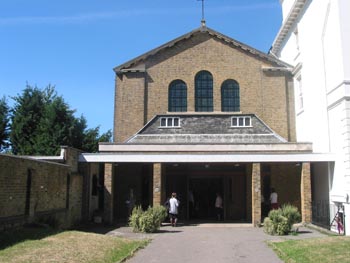Text and Illustrations from Wikipedia - the free encyclopaedia,
unless otherwise stated.

Bede, translating the Gospel
of Saint John on his deathbed.
Date: 1902.
Author: James Doyle Penrose.
(Wikimedia Commons)

Death of Saint Bede.
(From the Original Picture at Saint Cuthbert's College,
Ushaw, Durham, England).
Death of Saint Bede. Project Gutenberg eText 16785.
From The Project Gutenberg EBook of Our Catholic Heritage
in English Literature of Pre-Conquest Days, by Emily Hickey.
Source: http://www.gutenberg.org/etext/16785.
(Wikimedia Commons)
And he used to repeat that sentence from Saint Paul: “It is a fearful thing to fall into the hands of the living God,” and many other verses of Scripture, urging us thereby to awake from the slumber of the Soul by thinking in good time of our Last Hour. And, in our own language — for he was familiar with English poetry — speaking of the Soul’s dread departure from the body:
Facing that enforced journey, no man can be
More prudent than he has good call to be,
If he consider, before his going hence,
What for his spirit of good hap or of evil
After his day of death shall be determined.
Fore ðæm nedfere nænig wiorðe
ðonc snottora ðon him ðearf siæ
to ymbhycgenne ær his hinionge
hwæt his gastæ godes oððe yfles
æfter deað dæge doemed wiorðe.

Tomb of The Venerable Bede,
The Galilee Chapel,
Durham Cathedral.
Photo: 4 May 2008.
Source: http://flickr.com/photos/
Author: robert scarth.
(Wikimedia Commons)
On the other hand, the inclusion of the Old English text of the poem in Cuthbert’s Latin Letter, the observation that Bede "was learned in our song," and the fact that Bede composed a Latin poem on the same subject, all point to the possibility of his having written it.
By citing the poem, directly, Cuthbert seems to imply that its particular wording was somehow important, either since it was a vernacular poem endorsed by a scholar, who evidently frowned upon secular entertainment, or because it is a direct quotation of Bede’s last original composition.

The Galilee Chapel at Durham Cathedral,
where Saint Bede's Tomb is located.
Photo taken by James Valentine, circa 1890.
This File dated 17 July 2005.
Source: en-WP.
Author: en:User:Bhoeble.
(Wikimedia Commons)
Bede's cult became prominent in England during the 10th-Century Revival of Monasticism, and, by the 14th-Century, had spread to many of the Cathedrals of England. Wulfstan, Bishop of Worcester (circa 1008 – 1095) was a particular devotee of Bede's, Dedicating a Church to him in 1062, which was Wulfstan's first undertaking after his Consecration as Bishop.
His body was 'translated' (the Ecclesiastical term for relocation of Relics) from Jarrow to Durham Cathedral around 1020, where it was placed in the same tomb as Saint Cuthbert of Lindisfarne. Later, Bede's remains were moved to a Shrine in the Galilee Chapel, at Durham Cathedral, in 1370. The Shrine was destroyed during the English Reformation, but the bones were re-buried in the Chapel. In 1831, the bones were dug up and then re-buried in a new tomb, which is still there. Other Relics were claimed by York, Glastonbury and Fulda.

English: Galilee Chapel, Durham Cathedral.
(Saint Bede's Tomb can be seen on the right,
with a Prie-Dieu in front of it.)
Norsk: Durhamkatedralen, Galilee-kapellet.
Photo: 19 November 2004.
Source: Own work.
Author: Nina Aldin Thune.
(Wikimedia Commons)
His Feast Day was included in the General Roman Calendar in 1899, for celebration on 27 May, rather than on his date of death, 26 May, which was then the Feast Day of Pope Saint Gregory VII. He is Venerated in both the Anglican and Roman Catholic Church.
Bede became known as Venerable Bede (Latin.: Beda Venerabilis) by the 9th-Century, but this was not linked to consideration for Sainthood by the Roman Catholic Church. According to a legend, the epithet was miraculously supplied by Angels, thus completing his unfinished epitaph. It is first utilised in connection with Bede in the 9th-Century, where Bede was grouped with others, who were called "Venerable" at two Ecclesiastical Councils held at Aix-le-Chappelle in 816 A.D. and 836 A.D. Paul the Deacon then referred to him as "Venerable", consistently. By the 11th- and 12th-Centuries, it had become commonplace. However, there are no descriptions of Bede, by that term, right after his death.
THIS CONCLUDES THE ARTICLE ON THE VENERABLE BEDE.



